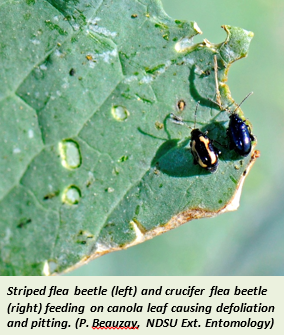Field monitoring for flea beetles and their feeding injury (defoliation, pitting in cotyledons/true leaves) is crucial since populations can increase rapidly in hot temperatures, says Janet J. Knodel. Monitor canola fields from seedling through the 4- to 6-leaf stages. Injury occurs first at the field edges, particularly where a shelterbelt or grassy area borders a field.
To determine the extent and distribution of damage, start at the field margins and walk a W-pattern into the field, selecting plants at various random intervals, says the entomologist from North Dakota State University. Estimate percent defoliation for each plant selected. Fields should be checked daily to identify economic injury or poor performance of insecticide seed treatments.

For foliar insecticide applications, the action threshold is when an average of 20-25% defoliation on the cotyledons and/or first true leaves, and beetles are actively feeding in the field.
Foliar treatments must be made quickly, if defoliation exceeds 20-25%. Under high beetle densities, a delay of one to two days can result in the loss of an entire field. Apply insecticides during the sunny, warm part of the day when beetles are actively feeding on the plants.
Canola plants that have reached the 4- to 6-leaf vegetative growth stage or beyond can tolerate more feeding injury, unless flea beetles are feeding on the growing point.
During years when flea beetle populations are high through June, a yield loss of 10% is common even when the crop is protected with insecticidal seed treatments. Under these conditions, a later foliar insecticide treatment (21 days after planting) is often necessary to protect the crop from re-infestation and yield loss.
Pyrethroid insecticides (a.i. bifenthrin, deltamethrin, gamma-cyhalothrin, zeta-cypermethrin) provide good control of flea beetles and a 7-10 day residual at the high-labeled rate. Insecticides registered for flea beetle management in canola are listed in the 2018 North Dakota Field Crop Insect Management Guide E1143. Pesticide applicators must READ, UNDERSTAND and FOLLOW ALL LABEL DIRECTIONS.
For more information, please consult the NDSU Extension fact sheet Integrated Pest Management of Flea Beetles in Canola E1234 (revised).






Post a comment
Report Abusive Comment